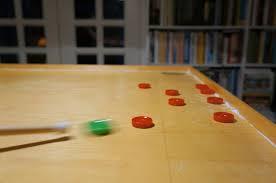Disk-shooting games like Korona and Carrom are among the most intriguing options, as board games have a unique ability to bring people together. Although both games involve flicking pucks or disks across a wooden board, their gameplay, strategy, and cultural history differ in many fascinating ways. This study analyzes what distinguishes Finland's Korona from the well-known Carrom, as well as why Korona is experiencing a boom in popularity among board game enthusiasts.
Origins of the two games
Carrom originated in South Asia and is several centuries old. It is now played all over the world, with India, Sri Lanka, Pakistan, and Bangladesh being among its most popular destinations. Korona, on the other hand, is a classic Finnish board game that rose to prominence in the twentieth century and is especially popular in Nordic households.
Despite their similarities, the two games have developed slightly different mechanics and cultural followings.
Game board and equipment
Initially, the game boards appear to be similar—they are both square with corner pockets and a smooth surface. The korona board, on the other hand, is frequently larger and has a glossy wooden surface, allowing for smoother disk movement. Carrom players use a small striker disk to smash lighter coins or pieces into the pockets, while Korona players flick their own set of wooden pucks straight with their fingers.
Korona disks are also slightly thicker and heavier than Carrom coins, adding to the game's tactile and physical challenge.
Rules and objective
In both games, your major goal is to get all of your pieces into the corner pockets before your opponent. However, your manner of getting there changes.
In Carrom, players alternate striking their pieces with a striker and aiming them into pockets. A queen (red piece) also exists, with its own rules and point values. To score a queen, players must cover it with another shot.
Korona is less ambiguous. Without a striker, players simply flick their own disks with their fingers. There is no queen or elaborate scoring system; the first player to sink all of their disks wins the game.
Skill vs precision
The use of the striker in carrom occasionally necessitates precise aim and a thorough understanding of angle mechanics. It's a game that rewards precise shots and deliberate setup. Korona, on the other hand, focuses more on reflexes and finger control; therefore, its execution is faster and more muscular.
Carrom typically attracts players who favor slow, thoughtful play, whereas Korona attracts those who want quick judgments and less formality.
Social and cultural appeal
Carrom is more of a social tradition in South Asia than a game. With tournaments and casual competitions becoming more common, families and friends join together to play during holidays and other celebrations.
Korona is experiencing a nostalgic resurgence in Finland as more young people rediscover it. Its simple design and enjoyable playability make it suitable for school events, bar competitions, and family nights. Its simple and pleasant gameplay make it great for family gatherings, bar tournaments, and school events.
Strategy and common winning tactics
Though Korona is simple in concept, success requires solid strategy. One common method is to first focus on the two nearest pockets to reduce danger, then go on to the further corners with precise flicks. Keeping control and picking the right angle before shooting can be really beneficial.
Which game is better?
In a board game, your preferences decide the outcome. Carrom is an excellent choice if you enjoy more complex rules and score structures, as well as methodical, strategic play. Korona is a unique and entertaining option if you prefer faster play with fewer rules and more physical contact, especially for newcomers to puck-based games.
Many players who try both appreciate Korona's tactile quality, particularly its direct flicking style without a striker. Easy to learn, fast to play, and extremely rewarding once mastered.
Conclusion
Although Korona and Carrom have a similar appearance and core premise, their gameplay, strategy, and cultural history differ significantly. While Korona keeps things quick, fun, and straightforward, Carrom introduces scoring rules and cautious, angled shots. Both are excellent games in their own right, but Korona is particularly Finnish and deserves a place at every board game enthusiast's table.
Whether you are a seasoned Carrom player or just starting out with Korona, both games provide hours of entertainment, friendly competition, and skill-building pleasure.

